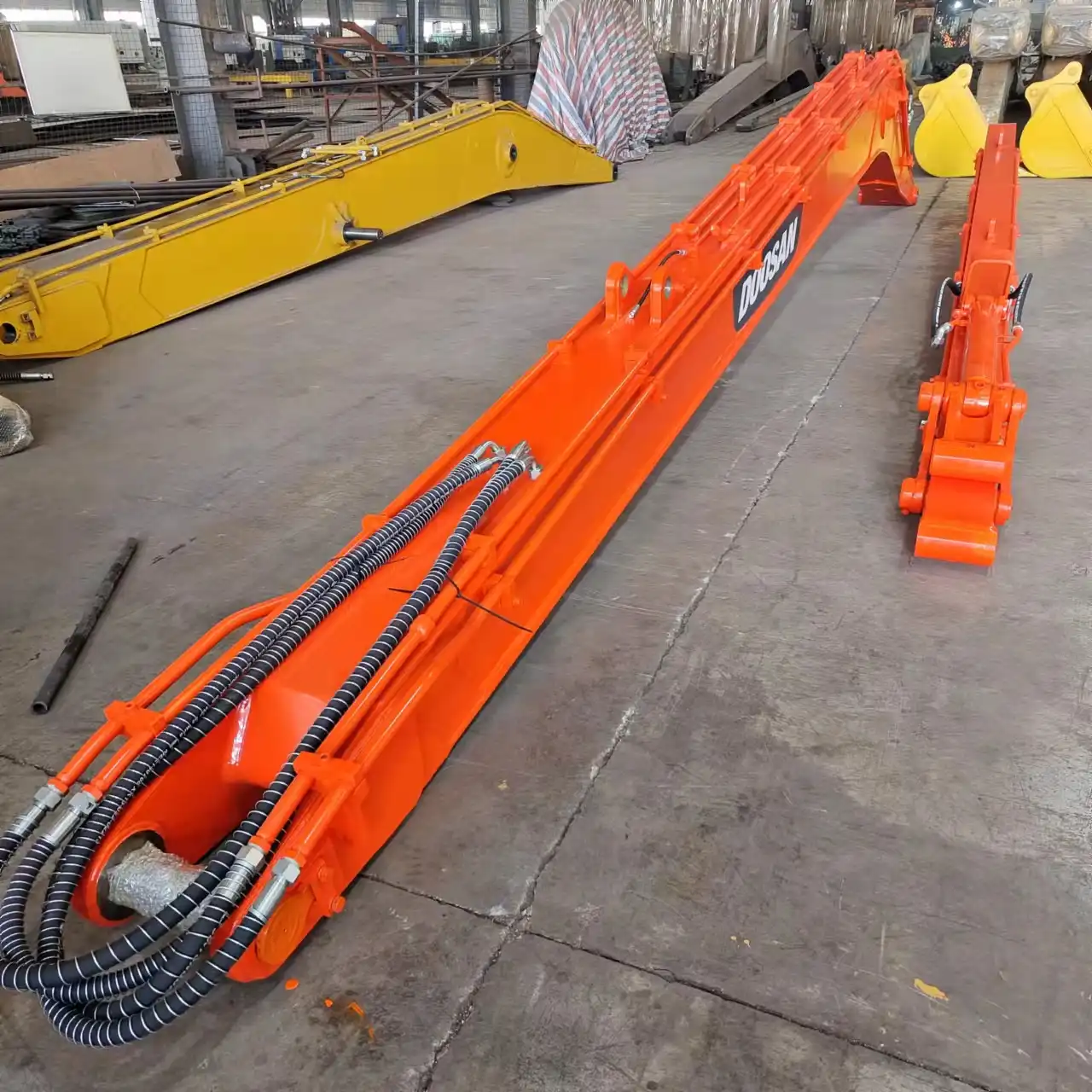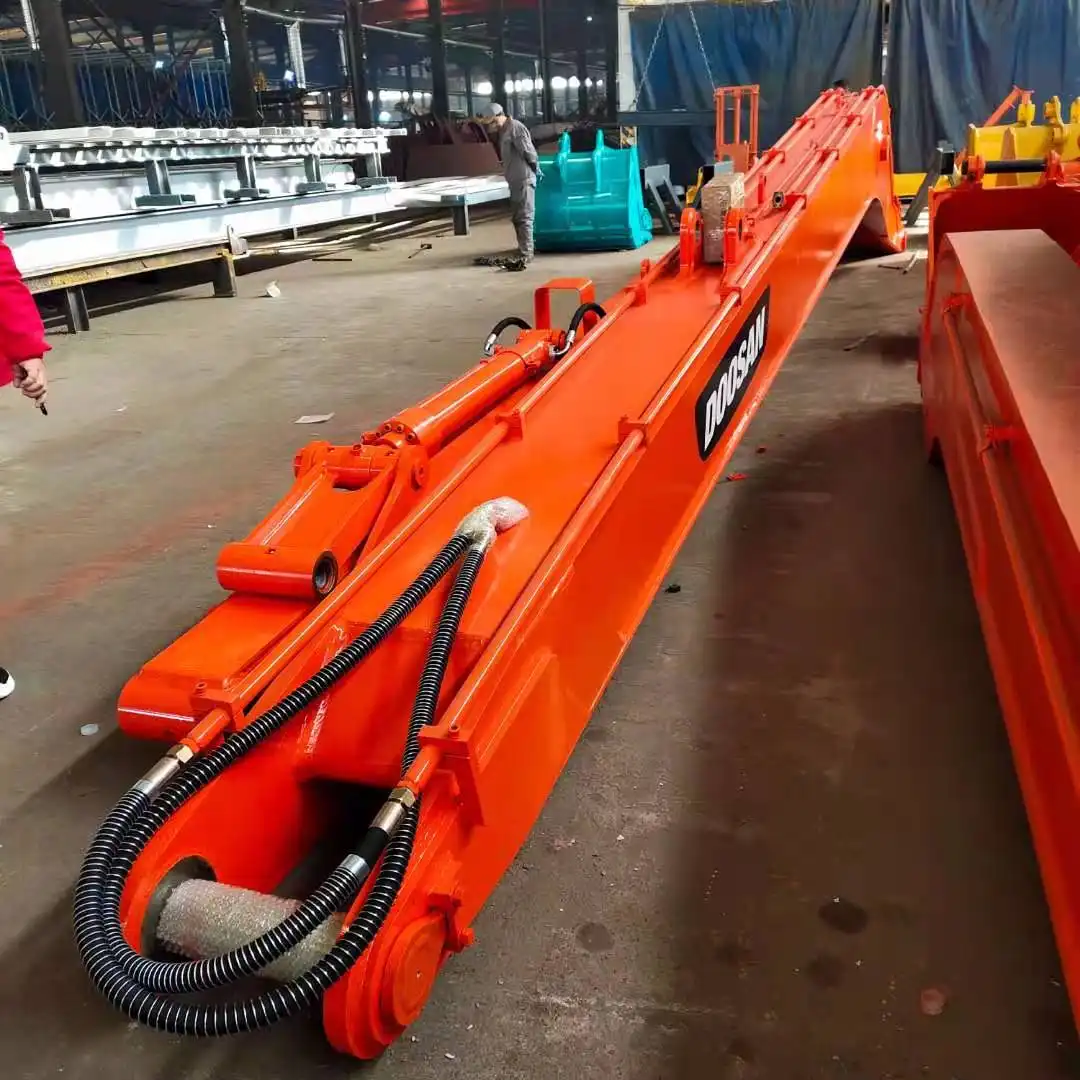What are the parts of an excavator arm?
Understanding the anatomy of an excavator arm is crucial for anyone involved in construction, mining, or heavy machinery operations. The arm exca assembly consists of three primary components that work harmoniously to deliver exceptional digging and material handling performance. These essential parts include the boom (the uppermost section that connects to the machine's cab), the arm or stick (the middle section that extends from the boom), and the bucket (the attachment that performs the actual digging work). Each component plays a vital role in the overall functionality of the excavation system, with hydraulic cylinders providing the power and precision needed for complex earth-moving tasks. The seamless integration of these parts allows operators to perform everything from delicate grading work to heavy-duty demolition projects. Modern excavator arms are engineered with durability and efficiency in mind, utilizing high-strength steel construction and advanced hydraulic systems to maximize productivity while minimizing downtime. Whether you're working in railway construction, mining operations, or general contracting, understanding these fundamental components helps ensure proper maintenance and optimal performance of your system.

Boom: Upper Section Of Excavator Arm
The boom is the largest and most prominent component of the excavator arm assembly, serving as the foundation for all excavation movements.
Construction and Design Features
The boom represents the backbone of any excavation operation, constructed from high-tensile steel that withstands tremendous forces during heavy-duty applications. This robust component connects directly to the excavator's main frame through a sophisticated pivot mechanism that allows smooth vertical movement. The boom's welded construction incorporates reinforcement plates at critical stress points, ensuring longevity even under the most demanding conditions. Its tubular design maximizes strength while minimizing weight, creating an optimal balance between power and fuel efficiency. The internal structure features carefully engineered stress distribution patterns that prevent fatigue cracking during repetitive operations.
Hydraulic Integration and Control Systems
Two powerful hydraulic cylinders typically control boom movement, though larger excavators may incorporate additional cylinders for enhanced lifting capacity. These cylinders receive pressurized hydraulic fluid from the machine's main pump system, allowing operators to achieve precise positioning and controlled force application. The hydraulic system's responsiveness enables smooth transitions between different working positions, whether performing deep excavation or high-reach demolition work. Advanced excavators feature proportional control valves that provide infinite positioning capabilities, allowing operators to maintain steady boom angles during complex operations.
Applications Across Different Industries
The boom's versatility makes it invaluable across various industries, from railway maintenance to mining operations. In construction environments, longer booms provide extended reach for pond cleaning and canal maintenance, while shorter configurations excel in confined spaces like urban demolition projects. Mining applications often require specialized heavy-duty booms capable of handling massive loads and abrasive materials. The boom's design directly influences the excavator's working envelope, determining maximum digging depth and horizontal reach capabilities.

Arm (Stick): Extends From Boom And Connects To Bucket
Mechanical Function and Movement Range
The excavator arm, also referred to as the stick or dipper, serves as the crucial intermediate component that extends the excavator's reach while maintaining precise control over bucket positioning. This component attaches to the boom's end through a heavy-duty pivot joint, allowing horizontal movement that significantly increases the machine's working radius. A single hydraulic cylinder powers the arm's movement, providing the force necessary to curl the bucket inward or extend it outward with remarkable precision. The arm's length directly affects the excavator's digging envelope, with longer arms providing greater reach but potentially reducing breakout force at maximum extension.
Specialized Arm Configurations
Different applications require specific arm configurations to optimize performance and efficiency. Standard arms work well for general excavation and loading operations, providing a balanced combination of reach and digging force. Long-reach arms excel in applications requiring extended horizontal reach, such as river dredging, slope work, and demolition of tall structures. These extended configurations may sacrifice some digging power but dramatically increase the machine's working envelope. Specialized tunnel arms feature compact designs that maximize digging force in confined spaces, making them ideal for underground construction and pipe installation projects.
Maintenance and Durability Considerations
The arm experiences significant stress during operation, making proper maintenance essential for long-term reliability. Regular inspection of pivot points and hydraulic cylinder connections helps prevent premature wear and potential failures. The arm's hydraulic cylinder requires particular attention, as it operates under high pressure and frequent cycling throughout the workday. Quality aftermarket replacement parts can provide cost-effective solutions while maintaining performance standards. Proper lubrication of pivot points and regular hydraulic fluid analysis help identify potential issues before they result in costly downtime.

Bucket
Bucket Types and Applications
The bucket serves as the excavator's primary working tool, directly contacting materials and performing the actual digging, scooping, and loading operations. Standard digging buckets feature curved designs with sharp cutting edges that efficiently penetrate various soil types and materials. Rock buckets incorporate reinforced construction with additional wear plates and heavy-duty cutting edges designed to handle abrasive materials and challenging digging conditions. Specialized attachments like wood grabs, rippers, and demolition tools can replace traditional buckets to expand the machine's capabilities for specific applications.
Cutting Edge Technology and Wear Protection
Modern buckets incorporate advanced wear protection systems that significantly extend operational life while maintaining cutting efficiency. Replaceable cutting edges and side cutters allow operators to restore peak performance without replacing the entire bucket assembly. Hard-faced weld overlays and bolt-on wear plates provide additional protection in high-abrasion applications. The bucket's cutting angle and profile directly affect digging performance, with steeper angles providing better penetration in hard materials while flatter profiles excel in loading applications.
Hydraulic Cylinder Integration
A dedicated hydraulic cylinder controls bucket movement, providing the curling and dumping actions necessary for material handling operations. This cylinder must deliver substantial force to achieve maximum breakout power while maintaining smooth operation during precision work. The hydraulic system's design allows for independent control of bucket movement, enabling operators to maintain optimal cutting angles throughout the digging cycle. Advanced systems incorporate regenerative circuits that improve cycle times and reduce hydraulic system strain during high-production applications.
FAQ
①How do hydraulic cylinders power excavator arm movement?
Hydraulic cylinders use pressurized fluid to extend and retract pistons, creating the linear motion that moves each arm component. The excavator's hydraulic pump pressurizes fluid that flows through control valves to specific cylinders based on operator input.
②What materials are excavator arms made from?
High-strength steel alloys form the primary construction material, often featuring specialized heat treatments and welding techniques to enhance durability and resistance to wear and fatigue.
③Can excavator arms be customized for specific applications?
Yes, manufacturers offer various arm lengths and configurations, including long-reach, standard, and compact designs to suit different operational requirements and working environments.
④How often should excavator arm components be inspected?
Daily visual inspections should check for hydraulic leaks, loose pins, and excessive wear, while comprehensive inspections every 250 operating hours help identify potential issues before they cause failures.
⑤What factors affect excavator arm performance?
Arm length, hydraulic system capacity, material quality, and proper maintenance all significantly impact performance, with longer arms providing greater reach but potentially reducing maximum digging force.
Looking for high-quality, customized excavator arms at competitive prices? Look no further! As leading manufacturers and suppliers in China, TianNuo Machinery specializes in providing a wide range of arm exca tailored to your specific needs. Whether you need long reach excavator booms, tunnel arms, rock arms, or any other type of arm, we've got you covered. Our product range is extensive, including unloading arm steel grabbing machines, standard size excavator booms and arms, excavator grab arms, piling booms, high reach demolition arms, and extension arms. Don't miss out on the opportunity to enhance your excavation operations with our top-notch products. Contact us now at rich@stnd-machinery.com for a free quotation and let's build a successful partnership together!
References
- Heavy Equipment Maintenance Manual: Excavator Systems and Components, 3rd Edition, Industrial Press
- Hydraulic Systems in Construction Equipment: Design and Applications, McGraw-Hill Professional
- Excavator Operation and Maintenance Handbook, Construction Equipment Publications
- Materials Engineering for Heavy Machinery: Steel Alloys and Heat Treatment, Technical Publications Inc.
- Construction Equipment Performance Analysis: Excavators and Earth Moving Machines, Engineering Press
About Author: Arm
Arm is a leading expert in the field of specialized construction and railway maintenance equipment, working at Tiannuo Company. Tiannuo specializes in manufacturing a wide range of products, including railway maintenance equipment like railway sleeper changing machines and screening machines, excavator modification equipment such as excavator lifting cabs, various engineering arms for excavators, excavator accessories like digging buckets, and engineering vehicle auxiliary equipment like loader buckets.

